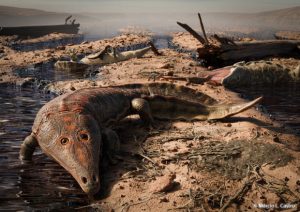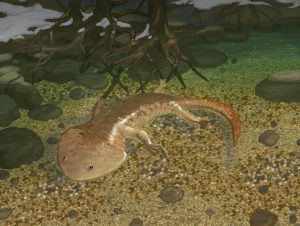Podcast: Play in new window | Download (Duration: 10:22 — 11.4MB)
Let’s take a look at some new findings about the temnospondyls this week!
Further reading:
Ancient giant amphibians swam like crocodiles 250 million years ago
Fossil of Giant Triassic Amphibian Unearthed in Brazil
Kwatisuchus rosai was an early amphibian [picture taken from article linked above]:

Koolasuchus was a weird big-headed boi:

Show transcript:
Welcome to Strange Animals Podcast. I’m your host, Kate Shaw.
This week we’re going to revisit an animal we talked about way back in episode 172, the temnospondyl. That’s because a new species of temnospondyl has been named that lived about 250 million years ago, and some other new information has been published about temnospondyls in general.
In case you haven’t listened to episode 172 in a while, let’s brush up on some history. The temnospondyls arose about 330 million years ago during the Carboniferous period. Ocean levels were high, the continents were coming together slowly to form the supercontinent Pangaea, and much of the land was flooded with warm, shallow water that created enormous swampy areas full of plants. Naturally, a whole lot of animals evolved to live in the swamps, and the temnospondyls were especially successful.
Temnospondyls were semi-aquatic animals that probably looked a lot like really big, really weird salamanders. This was before modern amphibians evolved, and scientists still aren’t sure if the temnospondyls are the direct ancestors of modern amphibians or just cousins that died out with no living descendants. Temnospondyls do share many traits with modern amphibians, but they still had a lot in common with their fish ancestors.
Most temnospondyls had large heads that were broad and flattened in shape, often with a skull that was roughly triangular. Some had smooth skin but many had scales, including some species with scales that grew into armor-like plates. The earliest species had relatively small, weak legs and probably spent most of their time in the water, but it wasn’t long before species with stronger legs developed that probably lived mostly on land.
Many temnospondyls were small, but some grew really big. The biggest found so far is Prionosuchus, which is only known from fragmentary specimens discovered in Brazil in South America. It had an elongated snout something like a ghavial’s, which is a type of crocodilian that mostly eats fish, and a similar body shape. That’s why its name ends in the word “suchus,” which refers to a crocodile or an animal that resembles a crocodilian. Inside, though, prionosuchus probably had more in common with its fish ancestors than with modern crocodiles, and of course it wasn’t a reptile at all. It was an amphibian, possibly the largest one that’s ever lived. The biggest specimen found so far had a skull that measured just over 5 feet long, or 1.6 meters. That was just the skull! The whole animal, tail and all, might have measured as much as 30 feet long, or about 9 meters, although most paleontologists think it was probably more like 18 feet long, or 5-1/2 meters. That’s still incredibly big, as large as the average saltwater crocodile that lives today.
The resemblance of many temnospondyls to crocodilians is due to convergent evolution, since researchers think a lot of temnospondyls filled the same ecological niche as modern crocodiles. If you’re an ambush predator who spends a lot of time hiding in shallow water waiting for prey to get close enough, the best shape to have is a long body, short legs, a long tail that’s flattened side to side to help you swim, and a big mouth for grabbing, preferably with a lot of teeth. A study published in March of 2023 examined some trace fossils found in South Africa that scientists think were made about 255 million years ago by a temnospondyl. The fossils were found in what had once been a tidal flat or lagoon along the shore of the ancient Karoo Sea. You didn’t need to know it was called the Karoo Sea but I wanted to say it because it sounds like something from a fantasy novel. Truly, we live in a wonderful world. Anyway, there aren’t very many footprints but there are swirly marks made by a long tail and body impressions where the animal settled onto the floor to rest.
From those trace fossils, scientists can learn a lot about how the animal lived and moved. The swirly tail marks show that it used it tail to swim, not its legs. Since there are hardly any footprints, it probably kept its legs folded back against its body while it was swimming. When it stopped to rest, it may have been watching for potential prey approaching from above, since its eyes were situated on the top of its head to allow it to see upward easily. All these traits are also seen in crocodiles even though temnospondyls aren’t related to crocodilians at all.
Other big temnospondyls that filled the same ecological niche as crocodiles were species in the family Benthosuchidae. Some grew over 8 feet long, or 2.5 meters. That may not seem very big compared to a dinosaur or a whale, but this is your reminder that it was an early amphibian, and that amphibians are usually little guys, like frogs and newts.
The newly discovered fossil I mentioned at the beginning of this episode has been identified as a member of the family Benthosuchidae. It’s been named Kwatisuchus rosai and was discovered in Brazil in 2022. That’s a big deal, because while temnospondyl fossils have been found throughout the world, until Kwatisuchus, benthosuchids have only been found in eastern Europe. It was five feet long, or 1.5 meters, and it was probably an ambush predator that mostly ate fish.
Kwatisuchus lived only a few million years after the end-Permian extinction event, also called the Great Dying, which we talked about in episode 227. That extinction event wiped out entire orders of animals and plants. Temnospondyls in general survived the Great Dying and hung on for another 100 million years afterwards.
The last temnospondyl that lived, as far as the fossil record shows, was Koolasuchus. It lived in what is now Australia and went extinct about 120 million years ago. This is a lot more recent than most temnospondyls, so much so that when it was first discovered, scientists at first didn’t think it could be a temnospondyl. It was only described in 1997, although it was first discovered in 1978.
Not only was Koolasuchus the most recently living temnospondyl, it was also big and heavy and very weird-looking. It was about 10 feet long, or about 3 meters, and might have weighed as much as 1,100 lbs, or 500 kg. It lived in fast-moving streams and filled the same ecological niche as crocodiles, which eventually replaced it after it went extinct.
Like its relations, Koolasuchus had a roughly crocodile-shaped body with short legs and a fairly long tail, but its head was almost as big as its body. Most temnospondyls had big heads, and Koolasuchus’s was broad and rounded with a blunt nose. It also had what are called tabular horns that projected from the rear of the skull, which gave its head a triangular appearance. Its body was relatively slender compared to the chonky head, which made it look kind of like a really really big tadpole.
Remember, as an amphibian, Koolasuchus would have laid eggs that hatched into a larval form the same way frogs do today. We have a lot of larval temnospondyl fossils and even some fossilized eggs that paleontologists think were laid by a temnospondyl, which were attached to water plants the same way many species of frog do today. Larval temnospondyls did look a lot like tadpoles. In other words, Koolasuchus looked like a tadpole in shape but its larval form was also probably tadpole-like. Extra, extra tadpole-shaped.
You can find Strange Animals Podcast at strangeanimalspodcast.blubrry.net. That’s blueberry without any E’s. If you have questions, comments, or suggestions for future episodes, email us at strangeanimalspodcast@gmail.com. We also have a Patreon at patreon.com/strangeanimalspodcast if you’d like to support us for as little as one dollar a month and get monthly bonus episodes.
Thanks for listening!